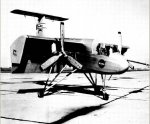Hi Guys,
If we can attach a 35hp engine to an ultralight fixed wing and get off the ground, why can't we use that same 35hp engine to blow air over a wing in some fashion and take off vertically?
Scot White
That has been done. The problem is always the same; Controlling the aircraft. By the time you create some complex control mechanism that will vector the air for control, it is always too heavy to fly with a pilot.
So... Add more horsepower.... but, that IS the paradox. More horsepower, more structure needed to contain the horsepower = more weight, which means larger control mechanism, so more horsepower needed, which = more weight, which means larger control mechanism, so more horsepower needed, which means larger control mechanism, so more horsepower needed, which = more weight, which means larger control mechanism, so more horsepower needed, which means larger control mechanism, so more horsepower needed, which = more weight, which means larger control mechanism, so more horsepower needed, which means larger control mechanism, so more horsepower needed, which = more weight, which means larger control mechanism, so more horsepower needed, which means larger control mechanism, so more horsepower needed, which = more weight, which means larger control mechanism, so more horsepower needed, which means larger control mechanism, so more horsepower needed, which = more weight, which means larger control mechanism, so more horsepower needed, which means larger control mechanism, so more horsepower needed, which = more weight, which means larger control mechanism, so more horsepower needed, which means larger control mechanism, so more horsepower needed, which = more weight, which means larger control mechanism, so more horsepower needed, which means larger control mechanism, so more horsepower needed, which = more weight, which means larger control mechanism, so more horsepower needed, which means larger control mechanism, so more horsepower needed, which = more weight, which means larger control mechanism, so more horsepower needed, which means larger control mechanism, so more horsepower needed, which = more weight, which means larger control mechanism, so more horsepower needed, which means larger control mechanism, so more horsepower needed, which = more weight, which means larger control mechanism, so more horsepower needed, which means larger control mechanism, so more horsepower needed, which = more weight, which means larger control mechanism, so more horsepower needed, which means larger control mechanism, so more horsepower needed, which = more weight, which means larger control mechanism, so more horsepower needed....
That's my point.


